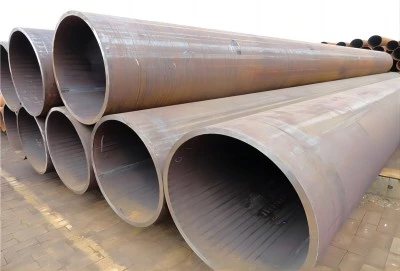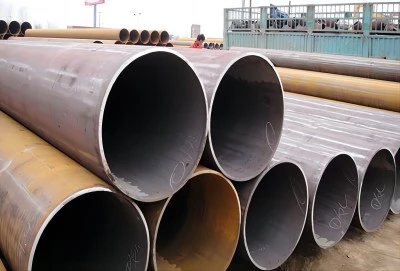Understanding the Basics of Double Seam Welding:
Double seam welding is an advanced pipe manufacturing technique that involves creating two longitudinal welds along the pipe's length, as opposed to the single weld found in traditional welded pipes. This process begins with a flat steel plate, which is carefully rolled into a cylindrical shape. The edges of the plate are then welded together to form the pipe's seam.
In double seam welded pipes, a second weld is applied on the opposite side of the pipe, creating a symmetrical structure. This additional weld serves multiple purposes:
- Reinforcing the pipe's overall strength
- Enhancing resistance to internal and external pressures
- Improving the pipe's ability to withstand various environmental stresses
- Reducing the risk of weld failure and leakage
The double seam welding process typically employs sophisticated welding techniques such as submerged arc welding (SAW) or electric resistance welding (ERW). These methods ensure precise control over the welding parameters, resulting in high-quality, consistent welds along the entire length of the pipe.
In contrast, single seam welded pipes rely on a single longitudinal weld to join the edges of the rolled steel plate. While this method has been widely used for many years and is still suitable for certain applications, it may not offer the same level of strength and reliability as double seam welding, particularly in high-stress environments.
How Double Seam Welding Improves Pipe Strength
The addition of a second weld in double seam welded pipes significantly enhances their structural integrity and performance characteristics. Here's how double seam welding contributes to improved pipe strength:
1.Enhanced Circumferential Strength:
The presence of two symmetrically placed welds along the pipe's circumference results in a more balanced distribution of stresses. This symmetry helps to minimize the concentration of stress at any single point, thereby increasing the pipe's ability to withstand internal pressure and external loads. The improved circumferential strength is particularly beneficial in applications involving high-pressure fluids or gases.
2.Increased Resistance to Longitudinal Stresses:
Double seam welding also enhances the pipe's resistance to longitudinal stresses, which are forces acting along the length of the pipe. These stresses can arise from various factors, including temperature changes, ground movement, and the weight of the pipe itself. The dual welds provide additional reinforcement against these forces, reducing the risk of pipe failure or deformation over time.
3.Superior Fatigue Resistance:
Fatigue is a critical concern in pipe systems subjected to cyclic loading or pressure fluctuations. Double seam welded pipes exhibit superior fatigue resistance compared to their single seam counterparts. The presence of two welds helps distribute the cyclic stresses more evenly, reducing the likelihood of crack initiation and propagation at the weld joints. This enhanced fatigue resistance translates to longer service life and improved reliability in demanding applications.
4.Improved Weld Quality and Consistency:
The double seam welding process often involves more advanced welding techniques and quality control measures. This results in higher overall weld quality and consistency throughout the pipe's length. The use of automated welding equipment and precise control of welding parameters ensures that both welds meet stringent quality standards, further contributing to the pipe's strength and reliability.
5.Enhanced Corrosion Resistance:
While the primary purpose of double seam welding is to improve structural strength, it can also contribute to enhanced corrosion resistance. The dual welds create a more uniform surface along the pipe's interior and exterior, reducing the likelihood of localized corrosion at the weld seams. Additionally, the improved weld quality and consistency help minimize potential weak points that could be susceptible to corrosive attack.
It's important to note that while double seam welded pipes offer significant strength advantages, they may require more sophisticated manufacturing processes and quality control measures. This can result in higher production costs compared to single seam welded pipes. However, the long-term benefits in terms of durability, reliability, and performance often outweigh the initial cost difference, especially in critical applications.
Applications Where Double Seam Welded Pipes Excel
The superior strength and reliability of double seam welded pipes make them particularly well-suited for a wide range of demanding industrial applications. Here are some key areas where these pipes have found extensive use:
1.Oil and Gas Industry:
In the oil and gas sector, double seam welded pipes are widely used for transmission pipelines, offshore platforms, and subsea applications. The high-pressure environments and corrosive substances encountered in this industry demand pipes with exceptional strength and durability. Double seam welded pipes meet these requirements, offering enhanced resistance to internal pressure, external loads, and fatigue stresses associated with long-distance fluid transport.
2.Petrochemical Plants:
Petrochemical facilities often involve the processing and transport of highly reactive and corrosive materials under extreme temperature and pressure conditions. Double seam welded pipes provide the necessary strength and reliability for these challenging environments, ensuring safe and efficient operations while minimizing the risk of leaks or failures.
3.Power Generation:
In power plants, particularly those utilizing high-pressure steam systems, double seam welded pipes play a crucial role. These pipes are used in boiler feed water lines, main steam lines, and other critical applications where the combination of high temperatures, pressures, and cyclic loading demands exceptional pipe strength and fatigue resistance.
4.Water Treatment and Distribution:
Large-scale water treatment facilities and distribution networks often employ double seam welded pipes for their main transmission lines. The improved strength and corrosion resistance of these pipes make them ideal for handling high-volume water flow over long distances, ensuring reliable water supply to urban and industrial areas.
5.Mining and Mineral Processing:
The mining industry relies on robust piping systems to transport abrasive slurries and corrosive chemicals. Double seam welded pipes offer the necessary strength and wear resistance for these applications, helping to minimize downtime and maintenance costs associated with pipe failures.
6.Chemical Processing:
Chemical plants often deal with hazardous and corrosive substances that require containment in high-integrity piping systems. The enhanced strength and reliability of double seam welded pipes make them a preferred choice for critical process lines, reactors, and storage tank connections in the chemical industry.
7.Offshore and Marine Applications:
In offshore platforms, ships, and marine structures, double seam welded pipes are used for various systems, including ballast water lines, fire-fighting systems, and process piping. The pipes' ability to withstand high pressures, corrosive seawater, and dynamic loads encountered in marine environments makes them invaluable in these applications.
8.High-Pressure Hydraulic Systems:
Industries relying on high-pressure hydraulic systems, such as heavy machinery manufacturing and aerospace, often utilize double seam welded pipes for their hydraulic lines. The pipes' superior strength and fatigue resistance ensure safe and reliable operation under the extreme pressures typical of hydraulic systems.
9.Cryogenic Applications:
In industries dealing with extremely low temperatures, such as liquefied natural gas (LNG) processing and storage, double seam welded pipes find use in cryogenic piping systems. The enhanced strength and toughness of these pipes help maintain their integrity under severe thermal stresses associated with cryogenic temperatures.
10.Nuclear Power Plants:
The nuclear power industry, with its stringent safety requirements, often specifies double seam welded pipes for critical systems. These pipes are used in reactor coolant loops, steam generators, and other high-integrity applications where reliability and safety are paramount.
While double seam welded pipes excel in these demanding applications, it's important to note that their use should be evaluated on a case-by-case basis. Factors such as specific operating conditions, regulatory requirements, and cost considerations play a role in determining the most suitable pipe type for a given application. In some less critical or lower-pressure applications, single seam welded pipes may still be a viable and cost-effective option.
The choice between double seam and single seam welded pipes ultimately depends on a careful analysis of the specific project requirements, including:
- Operating pressures and temperatures
- Fluid or gas characteristics
- Environmental conditions
- Safety considerations
- Expected service life
- Maintenance requirements
- Budget constraints
By considering these factors and consulting with experienced pipe manufacturers, engineers can make informed decisions to ensure the selection of the most appropriate pipe type for their specific needs.
Longma Group:
In conclusion, the advent of double seam welding technology has significantly advanced the capabilities of welded steel pipes, offering enhanced strength, reliability, and performance in a wide range of demanding industrial applications. As industries continue to push the boundaries of operational efficiency and safety, double seam welded pipes are likely to play an increasingly important role in critical infrastructure and process systems worldwide.
For more information on our range of double seam welded pipes and other high-quality steel pipe products, please don't hesitate to contact us. Our team of experts is ready to assist you in selecting the ideal piping solution for your specific needs.














